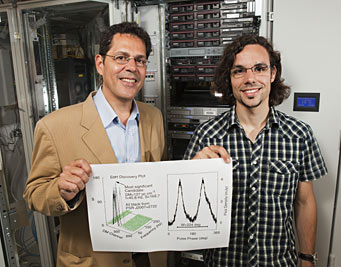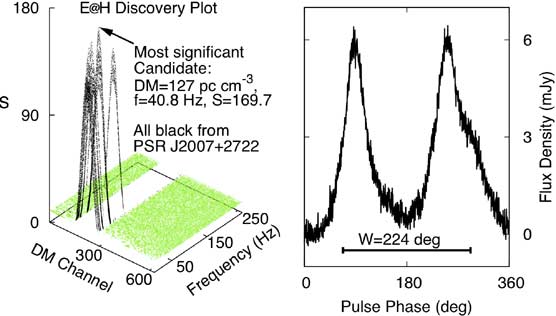First came SETI@home, which enabled millions of people to sign up their computers to sift through radio-telescope data for alien transmissions from the stars. Now 11 years old and running stronger than ever, SETI@home has opened the way for about 50 similar distributed-computing projects — in molecular biology, climate modeling, quantum chemistry, chess problems, and other number-crunching endeavors. Most of these run through BOINC, the Berkeley Open Infrastructure for Network Computing, which makes it easy to choose projects to join. A few clicks download the software and it runs out of sight, usually when your computer is in screensaver mode. Fancy displays are often available if you want to see what's going on.

Einstein@Home scientists Bruce Allen (left) and Benjamin Knispel proudly display the discovery plot.
Thomas Damm / AEI Hannover
Several of these projects involve astronomy. One called Einstein@Home started by examining data from the LIGO gravitational-wave observatory, looking for certain subtle signatures of spacetime ripples that might have escaped initial notice. Last year Einstein@Home expanded to took through radio data from an ongoing pulsar hunt at the Arecibo dish in Puerto Rico, using an algorithm that's especially sensitive to pulsars circling in very fast orbits around other objects. A quarter million people have installed Einstein@Home on their computers.
On June 11th Einstein@home made its first discovery: a pulsar drifting through space all by itself about 17,000 light-years away in Vulpecula. Designated PSR J2007+2722, it’s a previously unknown neutron star spinning 40.8 times per second. It seems to be a rare case of an old pulsar that was spun up by gaining mass from a companion that either blew up long ago or was eaten completely. It's the fastest such spinner on record.
The discovery took place on a computer running in the basement of Chris and Helen Colvin of Ames, Iowa. Three days later it was confirmed on a computer owned by Daniel Gebhardt in Mainz, Germany. It then brought itself to human attention.
About 2,000 pulsars are currently known. The project’s “holy grail,” says Cornell radio astronomer Jim Cordes, would be a pulsar orbiting something with a period of less than an hour. That would allow new tests of Einstein’s general relativity, the project's longterm goal.

Plots of the Einstein@Home discovery. Left: When everything was adjusted just right, the new pulsar (black) leaped out of the background noise (green). Right: The pulse profile seen at a radio frequency of 1.5 GHz, as recorded later with the 100-meter Green Bank Telescope in West Virginia.
AEI Hannover
 3
3
Comments
Mike M
August 17, 2010 at 4:30 pm
So you do what? Do you host the program on a spare computer for use by the scientists? Sorry about the naivete, but I'd like to have learned more about this from the article, which has left me a little confused.
You must be logged in to post a comment.
Beau
August 18, 2010 at 5:04 am
Just google "boinc" and you'll find their website.
I've participated with Seti and Einstein@home for several years. It's really exciting to see some results like this!
You must be logged in to post a comment.
jetgraphics
August 18, 2010 at 10:59 pm
And you might look into http://www.gridrepublic.org, a project manager tool for BOINC.
If you have more than one computer that you wish to run BOINC on, GridRepublic will manage them for you. So you only have to set up preferences and projects once, and subsequent installations can download your account data from GridRepublic.
You must be logged in to post a comment.
You must be logged in to post a comment.